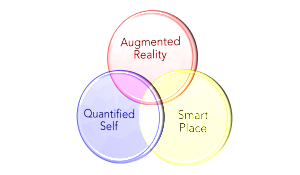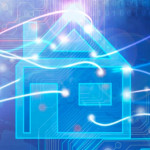Everything is getting “smart” and those ephemeral items that cannot be, get “enhanced”. At the Architechnologist we believe that affecting the experience of the world around us is possible in many ways, current technology gives us three main approaches to evolving our world:
 Changing our “input” through augmented reality (AR).
Changing our “input” through augmented reality (AR).
The purest form of technology changing experience itself, AR is the most adaptable, as flexible as the software. Visual AR hardware is in it’s infancy, but potential of systems like Google’s Glass and Epson’s Moverio is evident. Other varieties of augmented reality should not be overlooked: consider specially constructed and synchronized audio that is keyed to specific locations.
Using technology to force the question of reality versus perception, the innovations in this space can (and likely, will) change the common experience by creating experiences that are tailored to the individual and their preferences, also known as their “marketing demographic”.
 Adding faux intelligence to real-world objects, creating “smart places”.
Adding faux intelligence to real-world objects, creating “smart places”.
Adding functionality to physical items, connected devices change the experience by giving the appearance of independent action. Incredible growth and innovation in the “internet of things” (IoT) will be the backbone of the “internet of all”.
The missing piece that could tie the IoT together into the IoA is (still) a clearly defined, highly functional and incredibly stable structure that would also be platform agnostic and some mechanism for it. Currently the platform could be ZigBee, Z-Wave, a “bluetooth mesh” or some combination of them… or it could be something else entirely new. The hardware for the evolved Internet of All will likely be some variation of a network hub, specialized for access to the wide variety of devices.
Quantifying data from our personal actions.
Fitness tracking hardware, aka “wearable technology” is the woefully overlooked piece of the puzzle — the part that puts our physical experience into the equation, rather than just our presence. Action and activity plus the unique, personal input that makes the user more than simple data and larger than the expression “quantified self” could possibly represent.
Creating the “Internet of All”
The combination of these three pieces have the potential to create an augmented/smart/quantified future of personal experiences that are unique to each of us alone and connected to all of us together.
Start with an idealized “internet of things” where most everything is connected to some great big network and, more importantly, work together in an intelligent fashion. Utilizing information from the public internet (time, weather, location, etc) to give the functionality of a simple concierge to the locations that the user commonly visits and a modicum of personalization to every new place that is visited. With the addition of next-next-generation augmented reality (glasses, contact lenses, direct input to the optic nerves or whatever science fiction method you wish to insert), the Internet of All (IoA) moves past being a hyper-convenient world and into one that is ultra-personalized. The appearance of the world that the user is in changes to suit them at the same time that it changes to another’s preferences, since every user will perceive it in their own way. The “secret sauce” that makes the IoA more than window-dressing is the addition of the essential things that distinguishes one user from another, their physical and emotional state… the “self”.
In an IoA world, my experience is exactly what I might want or need it to be, rooms change to suit the work that I am doing. Doors unlock and open as soon as I get near, but only if I am intending to pass through them. Refrigerators make sure that they are stocked with foods of my choosing, but also make suggestions to ensure that my diet is best suited to the activities that are in store for me that day. The potential of the Internet of All lies in it’s completeness, each part improving the function and utility of the others.